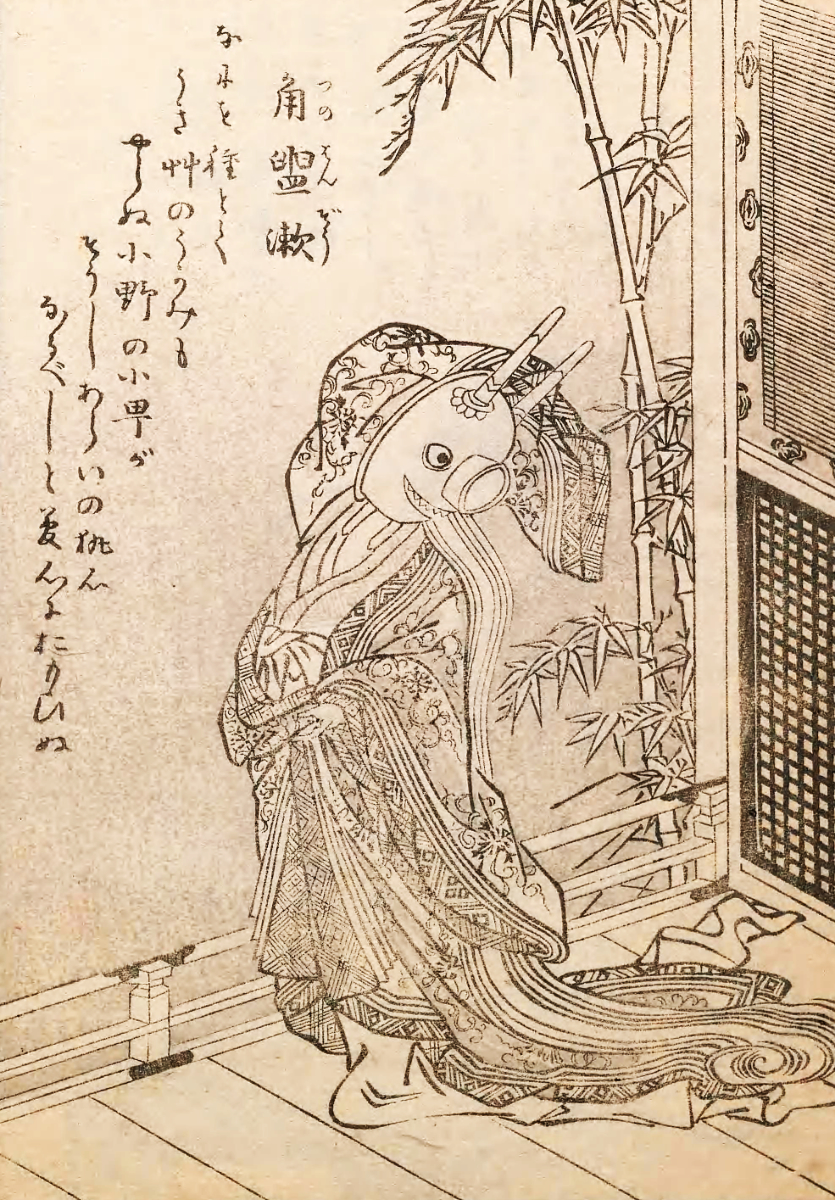Tsuno-darai refers to any lacquered washbowl. The tsuno-darai used particularly for rinsing mouth and throat is called a tsuno-hanzo (a lacquered washbowl with two pairs of long horn-like handles on the both sides). Tsunohanzo as a yokai portrayed in the “Gazu Hyakki Tsurezure Bukuro” is thought to be Sekien’s creation inspired by an episode of the tsunohanzo owned by Ono no Komachi, a waka poet who lived in the Heian period. It is said that Otomo no Kuronushi, who was one of the Rokkasen (six best Waka poets) like Komachi, plagiarized Komachi’s waka poem and introduced the poem in the anthology of waka poems. Finding out the plagiarism, Komachi attempted to prove the true authorship of her work and therefore poured some water from her tsunohanzo onto a page on which the waka in question had been handwritten with Chinese ink by Kuronushi, so that the letters were washed out, thereby exposing Kuronushi’s guilt. This anecdote is known as the story of “soshi-arai” (book washing). Sekien supposedly based his portrayal of the tsunohanzo as a yokai on this story. In his illustration, the Tsunohanzo looks like Komachi wearing juni-hitoe (twelve-layered ceremonial kimono) and has her tsunohanzo put in the place of the head with a pair of handles protruding like a demon’s horns as if they symbolized Komachi’s obsession. Tsunohanzo is one of Japanese yokai (ghosts, spirits and monsters) which is portrayed in Sekien Toriyama’s yokai art collection book, “Gazu Hyakki Tsurezure Bukuro” (The Illustrated Bag of One Hundred Random Demons; the term “hyakki” in its title is a pun on the usual hyakki, replacing the character for demon which is written as “鬼” in Japanese with a character for vessel written as “器,” and sure enough, most of the yokais shown in this book are tsukumogami, a type of Japanese spirits that originate in items or artifacts that have reached their 100th birthday and become alive. The book itself is a kind of the tsukumogami.
| Alias Tsunohanzō (角盥漱) |
| Real Names/Alt Names “Horned washtub” |
| Characteristics Yōkai, Enlightenment and Neoclassicism, Japanese |
| Creators/Key Contributors Toriyama Sekien, ○ |
| First Appearance Japanese folklore |
| First Publisher ○ |
| Appearance List Hyakki Tsurezure Bukuro (百器徒然袋, “The Illustrated Bag of One Hundred Random Demons” or “A Horde of Haunted Housewares”, c. 1781) Vol. 2 |
| Sample Read Hyakki Tsurezure Bukuro Vol. 2 (c. 1781) [Smithsonian] |
| Description Tsuno-darai refers to any lacquered washbowl. The tsuno-darai used particularly for rinsing mouth and throat is called a tsuno-hanzo (a lacquered washbowl with two pairs of long horn-like handles on the both sides). Tsunohanzo as a yokai portrayed in the “Gazu Hyakki Tsurezure Bukuro” is thought to be Sekien’s creation inspired by an episode of the tsunohanzo owned by Ono no Komachi, a waka poet who lived in the Heian period. It is said that Otomo no Kuronushi, who was one of the Rokkasen (six best Waka poets) like Komachi, plagiarized Komachi’s waka poem and introduced the poem in the anthology of waka poems. Finding out the plagiarism, Komachi attempted to prove the true authorship of her work and therefore poured some water from her tsunohanzo onto a page on which the waka in question had been handwritten with Chinese ink by Kuronushi, so that the letters were washed out, thereby exposing Kuronushi’s guilt. This anecdote is known as the story of “soshi-arai” (book washing). Sekien supposedly based his portrayal of the tsunohanzo as a yokai on this story. In his illustration, the Tsunohanzo looks like Komachi wearing juni-hitoe (twelve-layered ceremonial kimono) and has her tsunohanzo put in the place of the head with a pair of handles protruding like a demon’s horns as if they symbolized Komachi’s obsession. Tsunohanzo is one of Japanese yokai (ghosts, spirits and monsters) which is portrayed in Sekien Toriyama’s yokai art collection book, “Gazu Hyakki Tsurezure Bukuro” (The Illustrated Bag of One Hundred Random Demons; the term “hyakki” in its title is a pun on the usual hyakki, replacing the character for demon which is written as “鬼” in Japanese with a character for vessel written as “器,” and sure enough, most of the yokais shown in this book are tsukumogami, a type of Japanese spirits that originate in items or artifacts that have reached their 100th birthday and become alive. The book itself is a kind of the tsukumogami. |
| Source Tsunohanzo – Japanesewiki.com |

